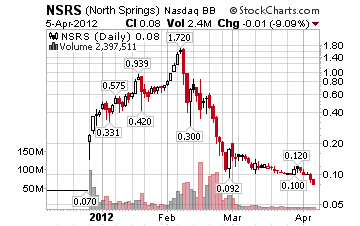 The movie Boiler Room that highlighted the Penny Stock Pump and Dump in graphic detail is still victimizing greedy investors globally until today. In the 70’s and 80’s, stock brokers in Canada used to send out prospectus material on penny stocks which had 80% of the front page used as a disclaimer stating that the broker/firm was to receive 80% or more as a commission from the purchase of these shares. Still, the risk seemed worth it since the story sounded good.
The movie Boiler Room that highlighted the Penny Stock Pump and Dump in graphic detail is still victimizing greedy investors globally until today. In the 70’s and 80’s, stock brokers in Canada used to send out prospectus material on penny stocks which had 80% of the front page used as a disclaimer stating that the broker/firm was to receive 80% or more as a commission from the purchase of these shares. Still, the risk seemed worth it since the story sounded good.
Even though Hollywood couldn’t make the scenario any more graphic in details when Boiler Room hit the screens more than 10 years ago, the scene expanded as “so-called” brokers went overseas to open shops in 3rd world countries like Thailand and Philippines where Asian and Australian investors were duped. They soon moved to Spain for the time-zone benefit of pushing their pump and dump restricted shares onto U.K and E.U. investors when Australia became too hot. But for some strange reason, the U.S. has been home to a long list of boiler room and pump and dump scandals that have been headlined by the likes of Enron, Bernie Madoff and The Stanford Group.
So how do you know if you’re involved with a Boiler Room or Pump and Dump?
Let’s start from the beginning. The term “penny stocks,” sometimes referred to as “micro-cap stocks,” are looked at in terms of their price less than their market capitalization. Most countries with large exchanges like the U.K., Singapore and Australia have very well known companies whose share prices are quoted in pennies which makes investing in penny stocks seem that less risky to them. Definitions in the U.S. vary, but in general, any stock with a market capitalization above $50 million and less than $300 million is considered a micro cap. According to the Securities & Exchange Commission (SEC), a stock on any exchange that trades under $5 is considered a penny stock.
“Hello is that John…….Excellent! John I have some FANTASTIC news about the company that we spoke about the other day, Grab a pen and write this down…..”
Again, definitions of a penny stock vary; some traders/investors set the cut-off point at $3, while others are literal to the meaning and consider only stocks that are trading less than $1 to be penny stocks. Some just go by the exchange and consider any stock that is trading on the pink sheets or over-the-counter bulletin board (OTCBB) to be penny stocks which is a huge miscategorization. The main point to understand about penny stocks (micro-cap stocks) is that they carry a higher degree of risk than traditional stocks.
“The stock is going to go to $10 – Buy Now!”
Four major factors make penny stocks both attractive and risky at the same time when compared to blue chip stocks:
1. The Lack of Public Information Available
Because Wall Street analysts and financial news correspondents rarely ever cover micro-cap stocks, obtaining enough tangible information to be able to make an informed decision is more difficult. For penny stocks, information can be much more difficult to find. When you start talking about companies that are listed on the pink sheets, they aren’t even required file with the SEC which makes investing in them like sticking your arm into a dark hole not knowing what could be inside. Even worse is that, even with all the hurdles the SEC has placed to protect investors, much of the information available on some micro-cap stocks comes from non-credible sources.
2. No Minimum Requirements
Stocks listed on the OTCBB and pink sheets exchanges have hardly any requirements necessary to remain listed on the exchange. The OTCBB does force companies to file their financial data in a timely fashion with the SEC. If a stock is listed on the larger exchanges but cannot meet the requirements such as trading above $1 for a period of 30 days, they will be regulated, delisted, from the major exchanges and moved to one of these smaller exchanges. As mentioned, the OTCBB does require companies to file timely financial data with the SEC. However, the pink sheets has no such requirement. Minimum requirements act as a safety net for traders/investors and acts as a benchmark for some companies.
3. Historical Deficit
Many penny stocks (micro-cap stocks) are either start-ups or on the brink of bankruptcy. These types of companies generally will have a poor track record if they even have one. As you can imagine, promise can only be traded on so much before some form of historical information is needed in order to determine a stock’s potential.
4. Liquidity (Volume)
Many penny stocks are liquid today and dry tomorrow. The meaning is that when a stock lacks liquidity, traders/investors are faced with two problems:
The possibility that you are stuck with crap and won’t be able to sell the position. If there is a low level of volume (liquidity), it can be difficult to find a buyer and you might just have to lower your price until it a buyer considers it attractive.
 Low volume (liquidity) levels open up the opportunity for traders to manipulate a stock’s price. This can be done in a number of different ways. The classic version is to buy, or own, a large amount of a stock, hype the hell out of it like what is being done with Sunpeaks Ventures (SNPK) and what was done with North Springs Resources (NSRS), and then sell it after duped traders/investors find it attractive – the Pump and Dump.
Low volume (liquidity) levels open up the opportunity for traders to manipulate a stock’s price. This can be done in a number of different ways. The classic version is to buy, or own, a large amount of a stock, hype the hell out of it like what is being done with Sunpeaks Ventures (SNPK) and what was done with North Springs Resources (NSRS), and then sell it after duped traders/investors find it attractive – the Pump and Dump.
How to Spot the Traps
The SEC has had issues with penny stocks for some time due to the lack of available timely information and poor liquidity which makes these types of stocks an easy “carrot on a stick” for fraudsters. There are so many boiler room type scams that are used to pry money from investors such as:
Recommendations from Biased Investment Firms
 Some firms will issue out an investment report on a penny stock or micro-cap company that gets paid by individuals to recommend the stock in social media, such as newsletters, investor reports, financial television and radio shows. Some just send out spam emails trying to coerce you into buying and holding patiently a particular stock. Any and all emails, message board postings, tweets, Facebook likes, click-ads and recommendations of that sort should be taken with a grain of salt. First thing to look for is if the issuer of the stock recommendation is being paid for their services and how much. Micro-cap companies will use these services with pure honesty behind it since pubic awareness needs to be created somehow. However, most of the time this is a giveaway that it is a bad long-term investment. Furthermore, verify any press releases about a stock aren’t produced falsely by people looking to influence a stock’s price.
Some firms will issue out an investment report on a penny stock or micro-cap company that gets paid by individuals to recommend the stock in social media, such as newsletters, investor reports, financial television and radio shows. Some just send out spam emails trying to coerce you into buying and holding patiently a particular stock. Any and all emails, message board postings, tweets, Facebook likes, click-ads and recommendations of that sort should be taken with a grain of salt. First thing to look for is if the issuer of the stock recommendation is being paid for their services and how much. Micro-cap companies will use these services with pure honesty behind it since pubic awareness needs to be created somehow. However, most of the time this is a giveaway that it is a bad long-term investment. Furthermore, verify any press releases about a stock aren’t produced falsely by people looking to influence a stock’s price.
“Hello Mr. White, this is Alfred E. Newman from DIY Investment Bank in Seychelles. I’m calling about some amazing investment opportunities in the U.S. Stock markets that I would like to make you aware of since you qualify as one of our potential investors……”
Never Go with Offshore Brokers
Under Rule 144, regulation S, a companies stock is permitted by the SEC to be sold outside the U.S. to foreign investors and exempt from registration. First of all there is a six-month required hold on this type of stock. Secondly, these types of stocks are normally issued to offshore brokers at huge discounts who, in turn, sell them back to investors for a substantial profit. Cold calling is a nuisance but by making a potential investor (an person with disposable cash) feel important and lucky coupled with providing attractive information, these boiler room brokers will turn on the high-pressure sales tactics once they have the recipient’s attention to coerce them to purchase stock.
The Penny Stock Misconception
Two most common misconceptions attached to penny stocks in respect to the boiler room pump and dump are that almost all of today’s blue chip stocks were also penny stocks at one time and that the more you buy, the more you make.
Hundreds of thousands of traders/investors have fallen into the trap of the first misconception believing that Coca-Cola, Apple and many other blue-chip companies were penny stocks once and have now appreciated to their high dollar stock prices. Cough, cough, cough, bullshit, cough. Many duped traders/investors have made this mistake because they look at the “adjusted stock price” which takes into account all the stock splits that have occurred over time. By taking a look at both Apple and Coca-Cola, you can see that the respective stock prices on their first days of trading on the exchanges were not the adjusted prices for splits which show something like six cents and two cents respectively.
The second reason that many boiler room pump and dump schemes have duped investors is the misconception that there room for appreciation. with room for appreciation comes room to own more of the stock. If a ten cent stock rises by five cents, you made a 50% return. Easy mathematics. Couple this together with high pressure sales tactics and the fact that a $4,000 investment can buy 40,000 shares and traders/investors are convinced that penny stocks are a quick, surefire way to increase profits. With great power comes great responsibility. The power to invest means you need to be responsible enough to see more than just the upside of penny stocks and not forget about the downside. A ten cent stock can just as easily go down by five cents and lose half its value. Most often, these stocks trade on momentum and there is a high probability that if you invest long-term in them or fail to trade correctly with stop-loss and limit orders that you will lose your entire investment.
The Bottom Line
Making money off of a pump and dump is not a crime. if you can trade a stock while it goes up and not get burned, you won. Being one of those traders/investors who fell asleep or couldn’t sell is when the scheme turns to scam. Yeah, some companies on the OTCBB and pink sheets are good quality companies like Nestle S.A., American Airlines parent AMR Corp., even the Original Soupman from Seinfeld is on the OTCBB and many of the OTCBB companies work extremely hard to pay their dues and make their way up to a more reputable Nasdaq or NYSE listing.
Penny stocks aren’t a lost cause, but with the boiler room and pump and dump schemes that are out there, they are very high-risk investments that are not suitable for every investor. Money is made by trading penny stocks – there is no lie to that at all. The difference between those who make money and those who lose money is the amount and extent of research conducted before getting into a trade. Investment clubs were popular at one point in time and an interesting technique that savvy investors do is share tips and tricks with one another. This is one of the simplest ideas to getting more research done and sifting through the crap.
Another way to research penny stock picks is to change your search criteria from all to last 24 hours, last 2 days or last week on a Google search. This can give you a big edge by knowing current information about any key developments of a particular company. It’s actually easier with penny stocks than it is with the blue-chip stocks because they aren’t in the spotlight as much.
Of course, you could avoid doing all this crap by yourself and let us do all the legwork for you by just becoming a member to our subscriber list. If you just want to cash in on the profits and not have to do all this research, you can sign up for no fee and just paper trade or watch how our stock picks perform without making any investment into a stock until you are sure we pick winners.
Share
APR

